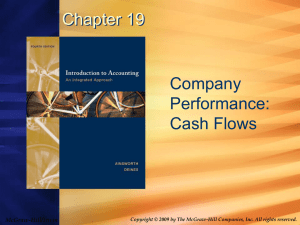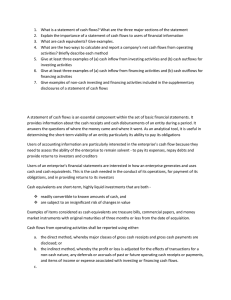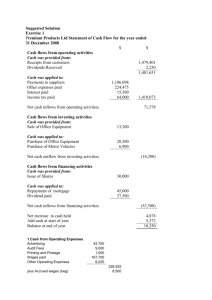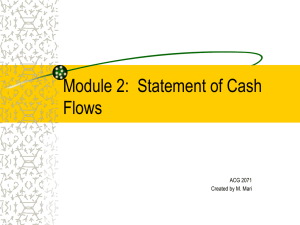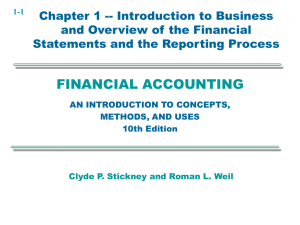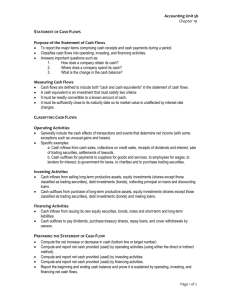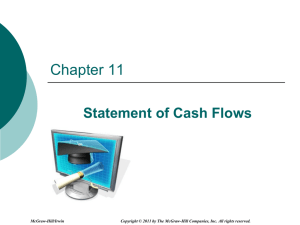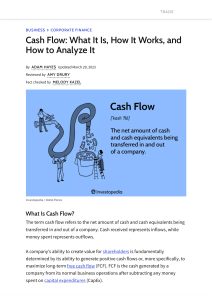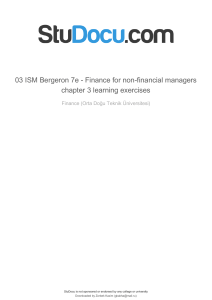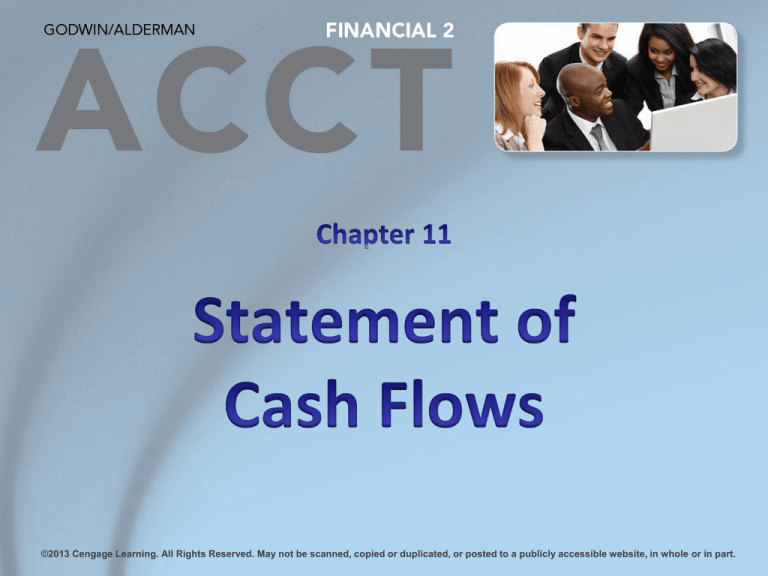
©2013 Cengage Learning. All Rights Reserved. May not be scanned, copied or duplicated, or posted to a publicly accessible website, in whole or in part.
The Purpose of the
Statement of Cash Flows
* Provides
information about
cash inflows and
outflows during a
period.
* Provides
information about
cash changes
between two
balance sheet dates.
* Discloses items
that affect the
balance sheet but
don’t show up in the
income statement.
* Categorizes
changes as
operating, investing,
or financing
activities.
The Basic Structure of the
Statement
Additional Disclosures
In some cases, companies must also make
one or both of the following two disclosures.
Significant noncash investing or
financing
activities
Cash paid for
interest and taxes
Preparing the Statement of
Cash Flows
Information for the statement of cash flows is
collected from a variety of sources
Preparing the statement of cash flows requires an
examination of the changes in all non-cash accounts
Therefore, in order to explain a company’s change in
cash, you must explain the changes in the company’s
noncash accounts. And to do that, you need the
following three items:
• A comparative balance sheet
• An income statement
• Additional information on changes in account balances
The Cash Change Equation
Assets
= Liabilities + Equity
Balance
Sheet
Equation
Cash + Non-Cash Assets = Liabilities + Equity
Balance
Sheet
Equation
Cash = Liabilities + Equity + Non-Cash
Assets
Cash
Change
Equation
Change Change in Change in Change in
in Cash = Liabilities + Equity - Non-Cash
Assets
6
Three Classifications of Cash Flows
1. Operations –
cash flows related to selling goods and
services; that is, the principle business of the
firm.
2. Investing
–
cash flows related to the acquisition or sale
of noncurrent assets.
3. Financing
–
long term and short term cash flows related
to liabilities and owners’ equity; dividends
are a financing cash outflow.
Direct and Indirect Method
Direct method calculates cash flow from
operations by subtracting cash
disbursements to supplies,
employees, and others from
cash receipts from customers.
Indirect method calculates cash flow from
operations by adjusting net
income for noncash revenues
and expenses.
U.S. GAAP permits
either the direct or
the indirect
method;
a firm that presents
the direct
Mostmethod
firms
must
usea this
also show
reconciliation
method.
8
Reporting Cash Flows
from Operating Activities—
Direct Method
Operating activities include acquiring
and selling products in the normal
course of business. Different types of
businesses will have different
transactions that are included in cash
flows from operating activities.
Types of Operating Inflows of Cash
Operating Cash
Inflows Into Company
• Sales to customers,
• Collection of cash
from past sales that
were made on
credit, and
• Interest and
dividends received.
Company
Types of Operating Outflows of Cash
Operating Cash Outflows
from Company
Company
• Purchases of
merchandise for sale or
materials to
manufacture products,
• Payments for
operating expenses,
• Interest on debt, and
• Payments for services
and taxes.
Operating Activities - Direct Method
Calculating Cash Received from Customers
Operating Activities - Direct Method
Calculating Cash Paid for Inventory
Cash Paid for Operating Expenses
Cash
outflows for
operating
expenses
=
Operating
expenses
+ Increase in Payable
or
– Decrease in Payable
Other Revenues and Expenses in the
Operating Activities Section
Two items ignored in the Operating Activities
Section under the Direct Method
Depreciation
Gain/Loss on
Sale of
Equipment
Summary of Adjustments – Direct
Method
Reporting Cash Flows
from Operating Activities—
Indirect Method
+
+
Net Income
Non-cash expenses
Increases in current liabilities
+
-
Decreases in current assets
Increases in current assets
Decreases in current liabilities
Gains from investing & financing activities
+
Loss from investing and financing activities
=
Cash flow from operating activities
Types of Investing Inflows of Cash
Investing Cash Inflows
Into Company
• Sale of property,
plant, and
equipment,
• The sale of
securities (stocks
and bonds) of other
companies, and
• The receipt of loan
payments.
Company
Types of Investing Outflows of Cash
Investing Cash Outflows
from Company
Company
• Purchases of property,
plant, and equipment,
• Purchase of securities,
and
• Making loans as
investments.
Types of Financing Inflows of Cash
Financing Inflows Into
Company
• Selling Stock,
• Issuing Bonds,
• Contributions from
owners, and
• Borrowing from
banks on a longterm basis.
Company
Types of Financing Outflows of Cash
Financing Cash Outflows
from Company
Company
• Repayment of notes
and bonds,
• Cash payments to
repurchase stock
(treasury stock),
• Payment of dividends.
A Statement of Cash Flows (indirect method
shown) concludes by adding the Change in Cash to
the Beginning Cash balance to derive the Ending
Cash balance.
Hardin Supply Company
Statement of Cash Flows for the Year Ending 12/31/2012
$ 14
Net Income (amounts in thousands of dollars)
Depreciation and amortization expense
25
hhhhhhhhhhhhhhhhhhhh
Hhhhh
hhhhhhhhhhhhhhhhhhhh
hhhhh
Cash flow from operating activities
$ 35
hhhhhhhhhhhhhhhhhhhh
Hhhhh
hhhhhhhhhhhhhhhhhhhh
hhhhh
Cash flow from investing activities
(92)
hhhhhhhhhhhhhhhhhhhh
Hhhhh
hhhhhhhhhhhhhhhhhhhh
hhhhh
Cash flow from financing activities
30
Change in cash
$(27)
Cash, January 1, 2012
45
Cash, December 31, 2012
$ 18
The
Company
receives
$100 Cash
from a
customer
22
Free Cash Flow
The calculation starts with cash
flows from operating activities,
which is a measure of a company’s
ability to generate cash from its
current operations.
The cash that remains is
“free” to be used as the
company chooses.
It then subtracts
capital
expenditures,
which refers to the
cash that a
company spends on
fixed assets during
the year, and
dividends, which
are payments to
stockholders
during the year.
Cash Flow Adequacy Ratio
Cash flow adequacy ratio compares free cash flow to the
average amount of debt maturing in the next five years and
measures the ability to pay maturing debt.
The 6.3 ratio indicates that Under
Armour generated over $6.30 in free cash
flow for every $1 of debt maturing
in each of the next five years.
End of Chapter 11

